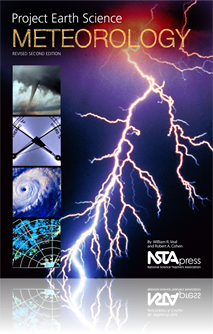All Book Chapters
Book Chapter
Environmental Effects of Acid Rain
Acid rain refers to rain water that is slightly acidic due to the presence of air pollutants like sulfur dioxide and nitrogen oxides, much of which come from power plants and auto emissions. Acid rain impacts lakes and streams, trees and forests, ...
Book Chapter
A hot air balloon uses hot air. You may have heard that hot air rises. In this Activity, you will explore what it is about hot air that makes it rise....
Book Chapter
Weather’s Central Actor: Water
Water plays an important role in weather, not only as a liquid in rivers, lakes, oceans, and clouds, but also as a vapor in the atmosphere and as a solid in snow, glaciers, ice, and clouds. The total quantity of water in all forms in Earth’s hyd...
Book Chapter
Wind is an important part of everyone’s daily lives. Have you ever flown a kite, thrown a disk, glided a paper airplane, or released a balloon into the air? All of these events have been affected by wind to some degree. If the wind blows rapidly, t...
Book Chapter
The Inner Workings of Severe Weather
Thunderstorms, tornadoes, and hurricanes are three examples of weather that can be dangerous to society. Such severe weather patterns require an understanding of the mechanisms responsible for their development, as well as timely observational and...
Book Chapter
The example of Models-Based Science Teaching (MBST) the author presents in this chapter is built upon the guided inquiry model. Inquiry has shown itself to be at least as effective as traditional approaches for content acquisition and better in creat...
Book Chapter
Brainstorms: From Idea to Invention
Learners explore the design process by improving an existing invention; designing and building a drink holder for an airplane seat and communicating their design process; and designing an investigation to evaluate Scotchgard. For more information on...
Book Chapter
Using a model, learners explore time zones and what causes day and night and how time zones change. Learners observed the position of the Sun in the sky at different times of day and relate those positions to the rotation of the Earth. For more info...
Book Chapter
Learners make drawing of what they think might be inside “energy balls,” small plastic spheres that light up and buzz. After investigating simple circuits using batteries, bulbs, and wires, they learn that electricity needs a complete loop to flo...
Book Chapter
Learners keep track of their households’ water use for one day, explore ways to conserve water and then create a Water Watch campaign for school or home. They also discover that clean water is limited in many places on Earth and learn about how wat...
Book Chapter
Learners explore how sound is produced by vibrations. They make a straw instrument and investigate how to vary its pitch. Learns also design and build an instrument that produces a high pitch and a low pitch and explain how it works. For more inform...
Book Chapter
Learners explore the differences between chemical and physical changes by observing a variety of changes in mater. Learners observe the chemical change of cooking pancakes and identify new menu items for the Chemical Change Café. For more informati...
Book Chapter
In this chapter, you will learn how experiments are structured. This structure or experimental setup is called the research design. The research design of an experiment determines both whether the experiment is likely to succeed and the reliability ...
Book Chapter
Close Encounters of the Symbiotic Kind
Learners explore how some organisms interact with other organisms through symbiotic relationships by observing “mystery objects” (plant galls) collected from the local ecosystem. For more information on how to implement Picture-Perfect Science in...
Book Chapter
By taking part in a simulation, learners explore the many threats to sea turtles and the ways humans can help them survive. Learns identify which dangers result from human actions and which dangers are natural. Learners also explore the life cycles o...





